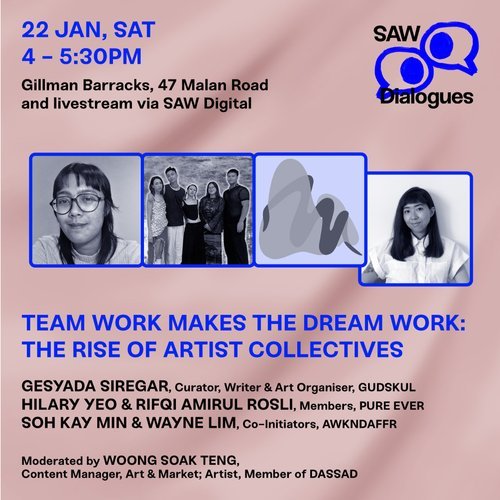SAW Dialogues 2022 | Conversation with Korakrit Arunanondchai
Korakrit Arunanondchai, May Adadol Ingawanij, and Chanon Kenji Praepipatmongkol
By Bryson Ng
Screenshot of talk. In clockwise direction: Chanon Kenji Praepipatmongkol, Curator, Singapore Art Museum, May Adadol Ingawanij, Writer, Curator & Educator, Korakrit Arunanondchai, Visual Artist & Flimmaker.
Key points:
The affective dimension of art allows audiences to make sense of their interpersonal and political realities.
Bridging conventionally contrasting ideas can lead to greater imaginative possibilities for art.
There is potential for collective storytelling to explore the human fascination with the unknown.
As part of SAW Dialogues 2022, ‘Conversation with Korakrit Arunanondchai: The Membrane Connecting All Things Visible’, co-presented with Singapore Art Museum (SAM) took place on 19 January from 8pm online. It was an engaging discussion about the immense potential for multimedia, storytelling art to meditate on the relationships between the old and the new, religion and modernity, and the collective and the individual. The panel featured visual artist and filmmaker Korakrit Arunanondchai, in dialogue with writer, curator and educator May Adadol Ingawanij. The session was moderated by Chanon Kenji Praepipatmongkol, Curator, SAM.
Here are the takeaways from the event:
The affective dimension of art allows audiences to make sense of their interpersonal and political realities. Korakrit expressed that his art often carries ideas that were inspired by his personal circumstances. The passing of his grandfather was one such key moment that was touched upon in ‘Songs for dying / Songs for living’, Korakrit’s first institutional solo exhibition at the Migros Museum für Gegenwartskunst, Switzerland. Through the intertwined themes of loss and grief, it presented a multimedia exploration into the relationship between the material and the immaterial worlds of the past and present. Korakrit explained that he hopes to tap into these universal emotional moments. He elaborated that art relates to wider political realities. For instance, his art was also influenced by the rising anti-military sentiment and movements in Thailand in recent years. May shared that Korakrit’s ‘Painting with history in a room filled with people with funny names 3’ deeply resonated with her as the installation highlighted the necessity of imagining a collective identity for individuals. Thus, it is through the mediation of both these personal and political realities that art can emotionally connect with and inspire audiences.
Bridging conventionally contrasting ideas can lead to greater imaginative possibilities for art. Korakrit explained that he often builds on possible overlaps between lines of thought that might seem starkly different in nature. For instance, he drew ideas from French object-oriented ontology and Animism for the creation of the installation ‘Painting with history in a room filled with people with funny names 3’. Korakrit explained that he attempted to overlay them with one another to build a meaningful conversation between both forms of thought. Korakrit added that the work also pushes the boundaries of storytelling art, through producing a narrative that infuses historical mythologies with ideas that revolve around the modern condition. For instance, Korakrit drew on the contemporary fascination with technological singularity, as well as the historical Buddhist myth of the Naga. Likewise, May noted that there is an infusion of both old and new narrative techniques in the installation, and demonstrates how such art highlights the evolution of the myth-making process in the contemporary age.
There is potential for collective storytelling to explore the human fascination with the unknown. Korakrit noted that there is an unparalleled potential for collective storytelling to explore the conditions of existence in the realm of the unknown. Korakrit also explained that methods of collective storytelling have have helped to conceive of religious imaginations of the afterlife. Korakrit highlighted that a key focus of ‘Songs for dying / Songs for living’ is to recognise the uncertainty of the unknown, and simultaneously to resist the modern tendencies to rationally interpret and taxonomise our experiences of the unknown. Korakrit also shared how the exploration of alternative moral systems in collective storytelling can provide deeper insight into the nature of our own society. By building such alternative narratives, one can then better understand the broader spectrum of morality in the world.
In conclusion, the ‘Conversation with Korakrit Arunanondchai’ panel discussion explored the potential for multimedia art forms to comment on the nature of myth-building in a time of modernity, as well as art’s potential in helping us make sense of our own socio-political realities. By bridging the old and the new, as well as the known and the unknown, such multimedia forms of collective storytelling continue to inspire a deeper engagement with the human imagination.
Watch the full recording of ‘SAW Dialogues 2022 | Conversation with Korakrit Arunanondchai: The Membrane Connecting All Things Visible’ here:
About the writer:
Bryson Ng is a writer and researcher of the arts, media, and the moving image. Having recently graduated from Yale-NUS with a major in Philosophy, Politics, and Economics, Bryson currently works for the National Library Board of Singapore as a Research Fellow of the digital humanities. In his free time, Bryson is an avid enthusiast of genre films, punk rock, and interacting with cats and dogs.















